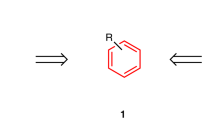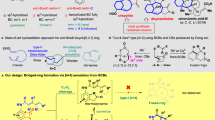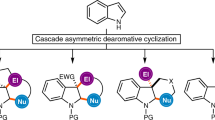Abstract
An important question in organic chemistry concerns the extent to which benzynes—one of the classical reactive intermediates in organic chemistry—can react in discriminating fashion with trapping reagents. In particular, whether these species can react selectively with substrates containing multiple functional groups and possible sites of reactivity has remained unanswered. Natural products comprise a palette of multifunctional compounds with which to address this question. Here, we show that benzynes produced by the hexadehydro-Diels–Alder (HDDA) reaction react with many secondary metabolites with a preference for one among several pathways. Examples demonstrating such selectivity include reactions with: phenolics, through dearomatizing ortho-substitution; alkaloids, through Hofmann-type elimination; tropolone and furan, through cycloaddition; and alkaloids, through three-component fragmentation–coupling reactions. We also demonstrate that the cinchona alkaloids quinidine and quinine give rise to products (some in as few as three steps) that enable subsequent and rapid access to structurally diverse polyheterocyclic compounds. The results show that benzynes are quite discriminating in their reactivity—a trait perhaps not broadly enough appreciated.
This is a preview of subscription content, access via your institution
Access options
Access Nature and 54 other Nature Portfolio journals
Get Nature+, our best-value online-access subscription
$29.99 / 30 days
cancel any time
Subscribe to this journal
Receive 12 print issues and online access
$259.00 per year
only $21.58 per issue
Buy this article
- Purchase on Springer Link
- Instant access to full article PDF
Prices may be subject to local taxes which are calculated during checkout






Similar content being viewed by others
References
Chen, M. S. & White, M. C. A predictably selective aliphatic C–H oxidation reaction for complex molecule synthesis. Science 318, 783–787 (2007).
Li, F. et al. Iminonitroso Diels−Alder reactions for efficient derivatization and functionalization of complex diene-containing natural products. Org. Lett. 9, 2923–2926 (2007).
Peddibhotla, S., Dang, Y., Liu, J. O. & Romo, D. Simultaneous arming and structure/activity studies of natural products employing O−H insertions: an expedient and versatile strategy for natural products-based chemical genetics. J. Am. Chem. Soc. 129, 12222–12231 (2007).
Tang, P., Furuya, T. & Ritter, T. Silver-catalyzed late-stage fluorination. J. Am. Chem. Soc. 132, 12150–12154 (2010).
Pathak, T. P. & Miller, S. J. Site-selective bromination of vancomycin. J. Am. Chem. Soc. 134, 6120–6123 (2012).
He, J., Hamann, L. G., Davies, H. M. L. & Beckwith, R. E. J. Late-stage C–H functionalization of complex alkaloids and drug molecules via intermolecular rhodium-carbenoid insertion. Nat. Commun. 6, 5943 (2015).
Sharma, A. & Hartwig, J. F. Metal-catalysed azidation of tertiary C–H bonds suitable for late-stage functionalization. Nature 517, 600–604 (2015).
Li, J. et al. Simultaneous structure–activity studies and arming of natural products by C–H amination reveal cellular targets of eupalmerin acetate. Nature Chem. 5, 510–517 (2013).
Huigens, R. W. III et al. A ring-distortion strategy to construct stereochemically complex and structurally diverse compounds from natural products. Nature Chem. 5, 195–202 (2013).
Mayr, H. & Ofial, A. R. The reactivity-selectivity principle: an imperishable myth in organic chemistry. Angew. Chem. Int. Ed. 45, 1844–1854 (2006).
Hoye, T. R., Baire, B., Niu, D., Willoughby, P. H. & Woods, B. P. The hexadehydro-Diels-Alder reaction. Nature 490, 208–212 (2012).
Trost, B. M. Sculpting horizons in organic chemistry. Science 227, 908–916 (1985).
Kitamura, T. Synthetic methods for the generation and preparative application of benzyne. Aust. J. Chem. 63, 987–1001 (2010).
Niu, D., Willoughby, P. H., Woods, B. P., Baire, B. & Hoye, T. R. Alkane desaturation by concerted double hydrogen atom transfer to benzyne. Nature 501, 531–534 (2013).
Willoughby, P. H. et al. Mechanism of the reactions of alcohols with o-benzynes. J. Am. Chem. Soc. 136, 13657–13665 (2014).
Zhang, J., Niu, D., Brinker, V. A. & Hoye, T. R. The phenol-ene reaction: biaryl synthesis via trapping reactions between HDDA-generated benzynes and phenolics. Org. Lett. 18, 5596–5599 (2016).
Liu, Z. & Larock, R. C. Facile O-arylation of phenols and carboxylic acids. Org. Lett. 6, 99–102 (2004).
Truong, T. & Daugulis, O. Divergent reaction pathways for phenol arylation by arynes: synthesis of helicenes and 2-arylphenols. Chem. Sci. 4, 531–535 (2013).
Karmakar, R., Yun, S. Y., Wang, K.-P. & Lee, D. Regioselectivity in the nucleophile trapping of arynes: the electronic and steric effects of nucleophiles and substituents. Org. Lett. 16, 6–9 (2014).
Garr, A. N. et al. Experimental and theoretical investigations into the unusual regioselectivity of 4,5-, 5,6-, and 6,7-indole aryne cycloadditions. Org. Lett. 12, 96–99 (2010).
Goetz, A. E. et al. An efficient computational model to predict the synthetic utility of heterocyclic arynes. Angew. Chem. Int. Ed. 51, 2758–2762 (2012).
Himeshima, Y., Sonoda, T. & Kobayashi, H. Fluoride-induced 1, 2-elimination of o-trimethylsilylphenyl triflate to benzyne under mild conditions. Chem. Lett. 12, 1211–1214 (1983).
Goto, K. & Takubo, K. Sinomenine and disinomenine. XXV. On three different sinomenine-methines. Bull. Chem. Soc. Jpn 6, 79–87 (1931).
Garcia, A., Drown, B. S. & Hergenrother, P. J. Access to a structurally complex compound collection via ring distortion of the alkaloid sinomenine. Org. Lett. 18, 4852–4855 (2016).
Chakravarti, R. N. & Robinson, R. 16. Strychnine and brucine. part XLVI. The preparation of neostrychnine and neobrucine. J. Chem. Soc. 1947, 78–80 (1947).
Wenkert, E. & Liu, L. H. The constitution of the alloyohimbanes. Experientia 11, 302–303 (1955).
Gaskell, A. J. & Joule, J. A. The zinc-acetic acid reduction of reserpine and other tetrahydro-beta-carboline alkaloids. Tetrahedron 24, 5115–5122 (1968).
Brecht, R. et al. Positional and facial selectivity in Diels–Alder reactions of (−)-(aS, 7S)-colchicine: synthesis of novel analogues of the alkaloid. Liebigs Ann./Recueil 1997, 851–857 (1997).
Wittig, G. & Pohmer, L. Intermediäre bildung von dehydrobenzol (cyclohexadienin). Angew. Chem. 67, 348–348 (1955).
Bhunia, A., Porwal, D., Gonnade, R. G. & Biju, A. T. Multicomponent reactions involving arynes, quinolines, and aldehydes. Org. Lett. 15, 4620–4623 (2013).
Karmakar, R., Mamidipalli, P., Yun, S. Y. & Lee, D. Alder-ene reactions of arynes. Org. Lett. 15, 1938–1941 (2013).
Tabushi, I., Yamada, H., Yoshida, Z. & Oda, R. Reactions of benzyne with substituted benzenes. Bull. Chem. Soc. Jpn 50, 285–290 (1977).
Paramjit, S. & Geeta, A. Organic synthesis under PTC: part 6—preparation and decomposition of chiral phase transfer catalysts derived from quinine. Indian J. Chem. B 25, 1034–1037 (1986).
Gui, Y. et al. A new chiral organosulfur catalyst for highly stereoselective synthesis of epoxides. Adv. Synth. Catal. 350, 2483–2487 (2008).
Hoffmann, R. W. Dehydrobenzene and Cycloalkynes (Organic Chemistry, A Series of Monographs Vol. 11, Academic, 1967).
Tadross, P. M. & Stoltz, B. M. A comprehensive history of arynes in natural product total synthesis. Chem. Rev. 112, 3550–3577 (2012).
Chen, J., Palani, V. & Hoye, T. R. Reactions of HDDA-derived benzynes with sulfides: mechanism, modes, and three-component reactions. J. Am. Chem. Soc. 138, 4318–4321 (2016).
Zhang, J., Yang, P. L. & Gray, N. S. Targeting cancer with small molecule kinase inhibitors. Nat. Rev. Cancer 9, 28–39 (2009).
Acknowledgements
These studies were supported by the US Department of Health and Human Services [National Institute of General Medical Sciences (GM-65597) and National Cancer Institute (CA-76497)]. The computational portions were carried out using software and hardware provided by the University of Minnesota Supercomputing Institute (MSI). NMR spectra were obtained using an instrument purchased with a grant from the NIH Shared Instrumentation Grant program (S10OD011952).
Author information
Authors and Affiliations
Contributions
S.P.R. and T.R.H. conceived the experiments, interpreted the data, co-wrote the manuscript, and agreed to the content of the final submission. S.P.R. executed the experiments and collected the data.
Corresponding author
Ethics declarations
Competing interests
The authors declare no competing financial interests.
Supplementary information
Supplementary information
Supplementary information (PDF 17582 kb)
Rights and permissions
About this article
Cite this article
Ross, S., Hoye, T. Reactions of hexadehydro-Diels–Alder benzynes with structurally complex multifunctional natural products. Nature Chem 9, 523–530 (2017). https://doi.org/10.1038/nchem.2732
Received:
Accepted:
Published:
Issue Date:
DOI: https://doi.org/10.1038/nchem.2732
This article is cited by
-
Ring-opening functionalizations of unstrained cyclic amines enabled by difluorocarbene transfer
Nature Communications (2020)
-
Organic synthesis provides opportunities to transform drug discovery
Nature Chemistry (2018)
-
Taming reactive benzynes
Nature Chemistry (2017)
-
1,4-Diazabicyclo[2.2.2]octane in the synthesis of piperazine derivatives (microreview)
Chemistry of Heterocyclic Compounds (2017)



